Four innovations that will transform the way you live a decade from now.
By Luke Sacher
Two generations ago, yesterday’s vision of the future was showcased at the New York World’s Fair, Expo 67 and Walt Disney’s Tomorrowland. It was all about big things, produced by venerable Dow Jones conglomerates: moon rockets from Grumman and Lockheed/Martin, jumbo jets from Boeing, prefabricated housing made of “miracle materials” from Monsanto and DuPont,

www.istockphoto.com
monorails from AMF, communications satellites from Bell Laboratories, copying machines from Xerox. Today, a used smartphone has more processing power than all of NASA’s computers combined had for the moon landings; a lowly iPhone 6 is 32,600 times faster than the Apollo-era IBM Model 360, which was as big as a car.
The iPhone just celebrated its 10th birthday silver-lined only a handful of technical wizards and scholastic futurists dared to predict the impact that mobile supercomputers would have on the lives of billions, and only a few got it right. Smartphones have forever changed the way we interact with our material world, and with one another. Answers to questions simple and complex are now always at our fingertips. If you have Siri or Alexa, you don’t even need to use your fingers. One could say that we’ve become simultaneously smarter and dumber, but for better or worse, the fact is that the world will never go back to what it was a decade ago.
So what’s coming down the pike right now that holds the same game-changing potential? Here are four of the most promising new inventions, clouds that truly seem to be 100 percent silver-lined.

www.istockphoto.com
MEMORIES STICK
DNA STORAGE
In 1965, Gordon Moore, co-founder of Fairchild Semiconductor and Intel, predicted that the number of transistors that could be printed onto microprocessor chips would double every year, and chip performance/speed would double every 18 months. His prediction became known as “Moore’s Law.” What Moore may not have foreseen is that every five years, the amount of digital data worldwide increases roughly tenfold. Microprocessor chips and most data storage devices are made of silicon, hence the name Silicon Valley. Computers store and process data on silicon chips as binary digits (zeros and ones) via tiny electrical charges. The problem is that the physical limit of microchips as a medium for data storage and processing is fast being reached. Which means that instead of computers getting smaller and smaller, they will soon have to get bigger and bigger to manage all that data. Engineers and manufacturers simply can’t squeeze any more circuits onto microchips beyond a gap of a few atoms, and so can no longer build them fast and dense enough to keep pace with demand.
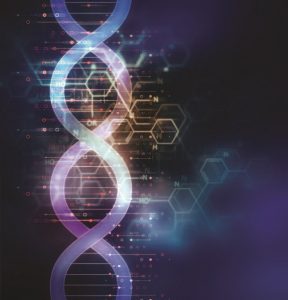
www.istockphoto.com
So what’s the alternative? Leonardo DaVinci said that the best solutions to most scientific problems were to be found in Nature and, in this case, it turns out he may have been right on the money. Over billions of years of biological evolution, Nature has generated the most advanced information storage medium currently known: DNA.“Oh, sure,” you’re saying, “I already know that DNA holds all the genetic data for building every living thing on Earth, but what can it do for me?” How about everything from saving your vacation photos to curing cancer?
The theory of storing digital data in DNA was conceptualized decades ago, but recent progress in applied biophysical technology is making it both possible and practical, perhaps sooner than anyone might think. DNA is much denser than silicon/nonorganic based media. The data for hundreds of thousands of DVDs (hundreds of terabytes) could fit on a thumbnail-sized quantity of DNA. It is also much more durable and, as we know, lasts virtually indefinitely. In comparison, nonorganic media may last only years or decades, and their formats and connection standards become obsolete even faster. DNA? Nope.
Traditional media such as hard drives, thumb drives and DVDs store data as sequences of binary code (0s and 1s) by modulating their electromagnetic and optical properties. DNA molecules store data as sequences of four component molecules called nucleotides: adenine, cytosine, thymine and guanine (A, C, T and G). The trick is to translate binary code to the quaternary code of DNA: 00 = A, 01 = C, 10 = T and 11 = G. For example, let’s say that a JPEG file’s first eight bits are 01111000. Break them into pairs (01 11 10 00), and translate those pairs to C-G-T-A. After determining what order the letters should go in, series of DNA strands are synthesized letter by letter, using an apparatus that takes bottles of As, Cs, Gs and Ts and mixes them in a liquid solution with “control” chemicals, which direct the reactions for their sequencing. By default, the process yields a secondary benefit of DNA storage: backup copies. Rather than making one strand at a time, it makes many identical strands at once before proceeding to the next strand in the series. Once the DNA strands are created, they must be protected against damage by drying them out and sealing them in containers that keep them cold and block water and light.
Perhaps the greatest advantage of DNA over electronic circuits is that it can interact with a biochemical environment like the human body. Computing with molecules involves recognizing the presence (or absence) of certain molecules, so a natural application of DNA computing is in the realm of bio-sensing and delivering medicines inside living organisms. DNA programs have already been put to medical uses, including diagnosing tuberculosis. Ehud Shapiro of the Weizmann Institute of Science in Israel has proposed a “nano-biological doctor in the cell” that targets cancer molecules. DNA can also be used to control motion, which introduces the possibility of creating DNA-based “nano-robots” to carry and deliver molecular cargo (therapeutic drugs) to precise disease targets inside humans. Remember the 1960s movie Fantastic Voyage? Imagine a miniaturized submarine made of DNA and Raquel Welch as a therapeutic drug!
DNA computation has enormous future potential. Its huge storage capacity, low energy cost, ease of manufacturing (which exploits the power of self-assembly and affinity with the natural world) are a gateway to nanoscale computing, using designs incorporating both molecular and electronic components. There remain many challenges to be addressed for the technology to move forward, but almost 100 years of traditional computer science techniques that have revolutionized silicon circuit design are now being applied to DNA-based computing. Progress so far has been steady and rapid. Onward and Inward!
GOING UP?
SIDEWAYS ELEVATORS
Over the past 50 years, many of the advanced fictional technological devices featured in the original Star Trek television series have been born into reality—flip phones, flat-panel video displays, and voice-activated computers to name three. Now add another one to the list: the Turbo Lift.
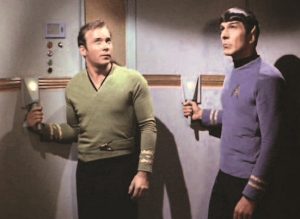
Paramount Television/CBS Television Distribution
German industrial and engineering conglomerate ThyssenKrupp (the same Krupp that forged the steel and built the armaments that turned Europe into a mass grave moonscape twice in the 20th Century) has created the MULTI, the world’s first vertical/horizontal elevator system. This past October, ThyssenKrupp premiered a fully functional “proof of concept” MULTI in its 800-foot test tower in Rottweil, Germany. The test tower has horizontal shafts only at its top and bottom, but OVG Real Estate’s East Side Tower in Berlin has contracted with the company to be the first actual building to install a complete “lattice grid” MULTI system later this year. The MULTI uses MAGLEV (magnetic levitation) propulsion technology, and “exchangers” at junctions of its X and Y axis tracks
“When we decided to take this type of exchanger, which was one in about twenty different concepts,” explains Markus Jetter, ThyssenKrupp’s head of product development for systems and components, “we found that this would also allow not only the change from vertical to horizontal but also to maybe any other angle in between.”
Conventional elevators are raised and lowered on counterweighted cables. They’re not very efficient. A lot of energy is used lifting the cables. MULTI is more energy-efficient than traditional cable/counterweight systems and, by running multiple cabins moving in a “loop” at up to 15 feet per second, the system can carry 50 percent more people—while also reducing wait times to between 15 and 30 seconds.
“Old School” elevators can only move along the Y-axis, and under the Newtonian Laws of fluid mechanics/inertia, can only rise to about 1,650 feet (500 meters). Sky-scrapers taller than that require multiple elevators and shafts, sometimes stacked on top of each other, in order to reach from the ground to top floors. The MULTI system’s “cable-free” design eliminates shaft height limits, releasing that constraint in skyscraper designs and allowing for far taller buildings to be economically feasible.
Shafts of cable elevators also take up a significant share of building floor space—as much as 40 percent in large skyscrapers. MULTI elevator cabins use common X and Y-axis shafts, thus significantly increasing a building’s occupied area. Their shafts are also roughly half the size of cable elevator shafts, which translates to more room for developers to install even more elevators. The MULTI design not only substantially increases the amount of occupancy space in single buildings, it could revolutionize metropolitan infrastructure and transportation, both for passengers and freight, since its elevators could travel between buildings, and not just up and down one. This is an architect’s dream come true
Might it be time to start thinking about preparing our farewells to taxicabs and subways and maybe even sidewalks?
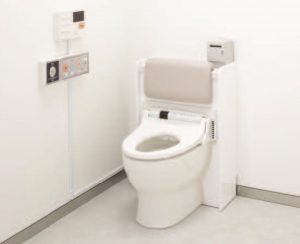
Photo Courtesy of Toto
GAME OF THRONES
THE SMART TOILET
I suppose it makes perfect sense that Japan, the most hygiene-obsessed and robot-friendly nation on earth—with a swelling population of senior citizens—would also be the leader in “Smart
Toilet” research and development. The world’s largest toilet manufacturer, Toto, has partnered with medical technology company Daiwa to create Flowsky.
Flowsky is fitted with a sensor that measures a user’s urine flow-rate and volume, while a tiny self-cleaning receptacle inside the bowl is used to collect 5cc of urine for comprehensive measurement of glucose, albumin and hormone concentrations, as well as detection of inflammation indicators like leucocytes and antibody proteins. Blood pressure, heart rate, weight and body mass index (BMI) are recorded via a blood pressure monitor located within arm’s reach of the toilet and a floor scale in front of the basin. Data is then sent by a built-in smartphone to the user’s primary care physician.
Flowsky is presently only available in Japan, and only in medical facilities, but most likely not for much longer. Nursing homes in Japan are filled to capacity, and the number of older people is increasing rapidly. Flowsky promises to reduce skyrocketing medical costs, as well as eliminate the laborious and time-consuming standard procedure of acquiring lab results. Future Flowsky models will be equipped to detect pregnancy and blood alcohol content, PSA, cholesterol and triglyceride levels, and to diagnose bacterial infections
“In Japan, most people see a doctor after they become ill,” explains Toto engineer Hironori Yamazaki. “With an eye to our demographic change, we are setting out to make the toilet a space for the early discovery of disease
Ten years from now, our toilets may well be the front line of healthcare, catching problems at the microscopic level long before symptoms manifest themselves. Personally, I can see a downside to this development. Right now, the toilet is the most trustworthy appliance in my house. I’m not sure I want the day to come where I ask myself, “Do I really trust my toilet?”
Will it only alert me to a looming medical issue, or is it going to it nag me about not going to the gym or remind me that I could be doing something smarter than vegging out on the couch scarfing down pork rinds? And then rat me out to my insurance carrier? In 2028, there may be no secrets we can keep from Son of Flowsky…or the iPot
CLEAR ENERGY
SOLAR WINDOWS
Everyone loves the sun, and always has—Sumerians, Egyptians, Greeks, Romans, Mayans, Japanese, Californians. Seems like any time in the last 10,000 years, you couldn’t swing a stick without hitting a sun worshipper. The ancients realized something we too easily overlook: the indisputably mind-blowing scientific fact that all forms of energy on our planet (kinetic, thermal, electromagnetic, nuclear) originate from our great big yellow fusion reactor in the sky. And all of the fuels used by humanity to generate usable heat and electricity—wind, water, wood, coal, petroleum, methane, plutonium, etc.—are indirect, inefficient storage media for solar energy. The ultimate objective of energy technology is to bypass all of those indirect media and find a way to tap “directly” into the sun.
By the best current (no pun intended) estimates, total global electrical energy demand could be satisfied using solar energy. The problem is that it would require covering 1 to 2 percent of the Earth’s flat landmass with collector cells yielding 10 percent efficiency. However, think of megacities all over the globe, from New York to Los Angeles to Hong Kong to Dubai to London, chock full of super skyscrapers with lots of vertical surface area. What covers that surface area? Windows. Yes, you might say, but windows of existing buildings can’t all be swapped out for solar panels. Solar panels are opaque and heavy and can only be installed on rooftops. And who would want to live or work in a windowless building? We’d all go mad as March Hares.
What if someone could invent a transparent (yes, transparent) film like window tinting in your car—made of abundant and inexpensive low environmental-impact materials—that could be laminated to every existing window in every city, capturing solar energy in the infrared and ultraviolet portions of the spectrum and converting it efficiently to electricity, while allowing the complete visible spectrum to pass through?
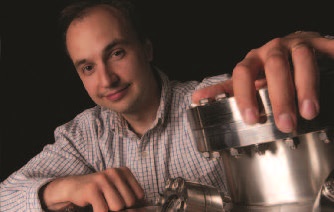
Courtesy of MIT
Trick question. It’s already happened. The two scientific rock stars leading the team that recently created this technology both earned their doctorates at Princeton University. Their résumés are as follows: Dr. Vladimir Bulovi ´ c, (left) Professor of Electrical Engineering and Associate Dean for Innovation at MIT, previously launched a number of technology companies including Kateeva and QD Vision—and is an inventor of over 50 patents in the field of
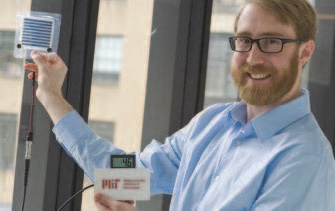
MIT
organic optoelectronics. Dr. Richard Lunt (right) of Michigan State University received his doctorate in chemical engineering from Princeton while working as a researcher there with Dr. Jay B. Benziger, and also with Dr. Stephen Forrest at the University of Michigan. While building his lab at MSU, he worked as a postdoctoral associate at MIT with Dr. Bulovic´. He has won numerous awards for his innovative research and has invented over 15 patents, most of which have been licensed.
In 2011, Bulovic´and Lunt founded their company, Ubiquitous Energy, in Redwood City, CA. This past autumn, they debuted their first practical transparent photovoltaic film prototype, called ClearView Power. ClearView Power transmits up to 90% of visible light, absorbing only ultraviolet and infrared wavelengths. It’s efficient: over 10% conversion to electricity is achievable and independent of its visible spectrum transparency. It’s economical: fabricated using low cost, non-toxic materials, and existing equipment. It’s thin and low-mass: the film is less than 1/1000th of a millimeter thick. And it does indeed have ubiquitous applications, generating electricity on any transparent surface without any aesthetic sacrifice.
This is what the beginning of the end of energy scarcity looks like, ladies and gentlemen. In my humble opinion, in 2028, we might be calling this the greatest technological achievement since the lever or the wheel.

www.istockphoto.com
FASTER! FASTER!
At present, DNA data storage is only experimental. Before it can be introduced to the marketplace, the processes of writing and reading DNA must be improved. Both are prone to error and relatively slow. Today’s DNA synthesis writes a few hundred bytes per second; a modern hard drive writes hundreds of megabytes per second. An average JPEG photo (like the one on the right) takes several hours to store in DNA, while it takes less than a second to save on the phone or transfer to a computer.

www.istockphoto.com
3-D ELEVATOR TRAVEL
With horizontal/vertical elevators coming online this year, the next holy grail for the elevator industry is three-dimensional (X-Y-Z axis) travel—a true Turbo Lift is not beyond the realm of present possibility, but still far from actuality. Currently, the drawbacks include cost. MULTI system elevators are five times as expensive as conventional ones. They won’t be adopted other than as a novelty until the return on investment (of increased throughput and reallocation of space) offsets their installation and maintenance costs. Another possible hurdle is shielding elevator occupants from the strong electromagnetic fields that propel them.





